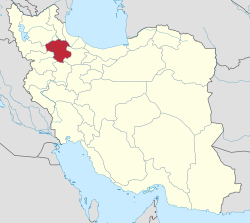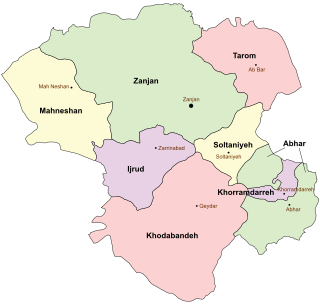Zanjan province
Zanjan province Persian: استان زنجان | |
|---|---|
 | |
 Location of Zanjan province within Iran | |
| Coordinates: 36°24′N 48°17′E / 36.400°N 48.283°E[1] | |
| Country | Iran |
| Region | Region 3 |
| Capital | Zanjan |
| Counties | 8 |
| Government | |
| • Governor-general | Mohsen Sadeghi |
| Area | |
• Total | 21,773 km2 (8,407 sq mi) |
| Population (2016)[2] | |
• Total | 1,057,461 |
| • Density | 49/km2 (130/sq mi) |
| Time zone | UTC+03:30 (IRST) |
| Main language(s) | Persian (official) local languages: Azerbaijani (Majority) Tati [3] |
| HDI (2017) | 0.771[4] high · 23rd |
Zanjan province (Persian: استان زنجان)[a] is one of the 31 provinces of Iran. Its capital is the city of Zanjan.[5] It is a mountainous province with close to 22,000 km2 of land placed in Iran's Region 3. Two-thirds of the people of the province live in the cities, mainly the capital and Abhar.
History
In Ptolemy's Geography, the city is referred to as Aganzana. It is said that the Sassanid king Ardashir I of Persia reconstructed the city and called it Shahin. Later it was renamed Zangan, whose present name is the Arabicized form. In past times Zanjan's name was Khamseh, which means "province with five tribes." Zanjan province incorporates areas of the former Gerrus province.[citation needed]
Former names
At least since the era of the Zand dynasty, Zanjan and its surrounding areas were called Khamseh. In a book named Mojmal al-Tawarikh-e Golestaneh, while discussing the events of the Karim Khan Zand era, it mentions the Mahal-e Khamseh (literally, "Khamseh areas") in reference to the regions of Zanjan province.[6] The use of Khamseh for Zanjan could precede the Zand era, since after the death of Nader Shah and the collapse of the great unification of the Afshar tribes, the tribe of Afshar-e Khamseh returned to the Mahal-e Khamseh. The tribe's name, therefore, had already contained the suffix of "Khamseh" since the era of Nader Shah, and possibly before they had left the Zanjan area to accompany Nader. It can be concluded that at least since the time of Nader and the Afsharids, the area was called Khamseh.[7]
It has been said that when Karim Khan Zand left Ardabil and Khalkhal to suppress Zaki Khan in Kashan, he entered Zanjan, and in Abhar he delegated the governorship of three areas of Mahal-e Khamseh to Zolfagharkhan-e Sultan Irluy-e Afshar. This is another indication of the area's having been named Khamseh at the time of Zands.[8][9]
During the following time of the Qajars, Zanjan province was also known as Khamseh. In the book Esker-ol-Tavarikh, Etemad Al-Saltaneh discusses Agha Mohammad Khan Qajar just before the formation of the Qajar dynasty, using the title of Hakem-e Khamseh (Governor of Khamseh).[10] In addition, Mirza Abolhasan Khan Shirazi in his travelogue in the year 1229 Hijri (around 1814) mentions Khamseh.[11] Among European travellers, the first person who used the name Khamseh for the province where Zanjan was located was Pierre Amédée Jaubert, sent by Napoleon Bonaparte to visit Fath Ali Shah's court, and in the year 1804 visited Zanjan city.[12]
Demographics
Ethnicity
Azerbaijanians are the main ethnic group in the province followed by Tats.[3] As in every other region of Iran, the lingua franca is Persian.
Population
At the time of the 2006 National Census, the province's population was 942,818 in 235,771 households.[13] The following census in 2011 counted 1,015,734 inhabitants living in 286,806 households.[14] The 2016 census measured the population of the province as 1,057,461 in 321,983 households.[2]
Administrative divisions
The population history and structural changes of Zanjan province's administrative divisions over three consecutive censuses are shown in the following table.
| Counties | 2006[13] | 2011[14] | 2016[2] |
|---|---|---|---|
| Abhar | 158,544 | 169,176 | 151,528 |
| Ijrud | 35,661 | 38,416 | 36,641 |
| Khodabandeh | 161,696 | 169,553 | 164,493 |
| Khorramdarreh | 60,027 | 65,166 | 67,951 |
| Mahneshan | 41,223 | 40,312 | 39,425 |
| Soltaniyeh[b] | — | — | 29,480 |
| Tarom | 42,939 | 46,616 | 46,641 |
| Zanjan | 442,728 | 486,495 | 521,302 |
| Total | 942,818 | 1,015,734 | 1,057,461 |
Cities
According to the 2016 census, 711,177 people (over 67% of the population of Zanjan province) live in the following cities:[2]
| City | Population |
|---|---|
| Ab Bar | 8,091 |
| Abhar | 99,285 |
| Armaghankhaneh | 2,149 |
| Chavarzaq | 1,733 |
| Dandi | 4,778 |
| Garmab | 3,823 |
| Halab | 956 |
| Hidaj | 13,840 |
| Karasf | 3,083 |
| Khorramdarreh | 55,368 |
| Mah Neshan | 5,487 |
| Nik Pey | 455 |
| Nurbahar | 3,644 |
| Qeydar | 34,921 |
| Sain Qaleh | 12,989 |
| Sohrevard | 6,991 |
| Sojas | 7,037 |
| Soltaniyeh | 7,638 |
| Zanjan | 430,871 |
| Zarrin Rud | 5,664 |
| Zarrinabad | 2,374 |
Geography

Zanjan has an area of 22,164 km2, occupying 1.34% of Iran's territory. The average population density in Zanjan is 47 people per km2. In the northwest of Iran, Zanjan shares borders with seven provinces: East Azerbaijan, West Azerbaijan, Hamadan, Kurdistan, Gilan, Qazvin, and Ardabil. The Zanjan River is the only major river in the region.[16]
Climate
Zanjan has a highland climate characterized by cold, snowy weather in the mountains and moderate climate in the plains in wintertime. In the summers, the weather is warm. The average maximum temperature of Zanjan is around 27 °C, whereas the average minimum temperature stands at −19 °C. Meanwhile, the temperature rises to 32 °C on hot days; it drops to −27 °C on cold days.[16]
The average annual rainfall in the first month of spring is 72 mm, while in the second month of summer, it is 3.6 mm. The rate of humidity in the morning averages 74% and at noon 43%.[16]
Economy
Zanjan province's economy benefits from its location connecting central Iran to the northwestern provinces. The railway and highway that connect Iran's capital city Tehran to Tabriz and Turkey pass through the province.
Agriculture is the principal occupation, and crops include rice, corn (maize), oilseeds, fruits, and potatoes. Poultry, cattle, and sheep are raised.[16] Zanjan is known regionally for its seedless grapes. Manufactured product includes bricks, cement, milled rice, and carpets. Chromium, lead, and copper are mined.[16] In the scientific world, Zanjan is the home of IASBS, one of the most productive research centers of the country.[17]
Handicrafts
Zanjan is known for its handicrafts, such as knives, traditional sandals called charoogh, and malileh (a handcraft made with silver wires). Zanjani artists produce many objects, like decorative dishes and their special covers, as well as silver jewelry. In ancient times, Zanjan was known for its stainless and sharp knives, but the tradition has gradually become extinct since the introduction of Chinese knives that are cheaper and more skillfully made. Many villagers today are traditional carpet weavers.[citation needed]
Higher education
The Institute for Advanced Studies in Basic Sciences IASBS, in the city of Zanjan, is one of Iran's most distinguished upper-level education and research centers in the pure sciences. Zanjan is home to the University of Zanjan, Zanjan University of Medical Sciences, and Islamic Azad University of Zanjan.[citation needed]
See also
![]() Media related to Zanjan Province at Wikimedia Commons
Media related to Zanjan Province at Wikimedia Commons
Notes
- ^ Also romanized as Ostân-e Zanjân; also known as Zangan province
- ^ Separated from Abhar County after the 2011 census[15]
References
- ^ OpenStreetMap contributors (9 September 2024). "Zanjan province" (Map). OpenStreetMap (in Persian). Retrieved 9 September 2024.
- ^ a b c d Census of the Islamic Republic of Iran, 1395 (2016): Zanjan province. amar.org.ir (Report) (in Persian). The Statistical Center of Iran. Archived from the original (Excel) on 27 April 2022. Retrieved 19 December 2022.
- ^ a b Government of Zanjan province (Persian) Archived 22 July 2011 at the Wayback Machine.
- ^ "Sub-national HDI – Area Database – Global Data Lab". hdi.globaldatalab.org. Retrieved 13 September 2018.
- ^ Habibi, Hassan (c. 2023) [Approved 7 July 1369]. Approval of the organization and chain of citizenship of elements and units of the national divisions of Zanjan province, centered in Zanjan city. lamtakam.com (Report) (in Persian). Ministry of the Interior, Defense Political Commission of the Government Council. Notification 82844/T141K. Archived from the original on 16 December 2023. Retrieved 16 December 2023 – via Lam ta Kam.
- ^ گلستانه, ابوالحسن بن محمدامین (1356). مجمل التواریخ (in Persian). Tehran: Tehran University. p. 455.
- ^ آصف, محمدهاشم (1382). رستم التواریخ (in Persian). Tehran: Donya-ye Ketab. p. 431.
- ^ غفاری کاشانی, ابوالحسن (1369). گلشن مراد (تاریخ زندیه) (in Persian). Tehran: Zarrin. p. 224.
- ^ نامی اصفهانی, محمدصادق (1363). تاریخ گیتی گشا (in Persian). Tehran. p. 169.
- ^ اعتضادالسلطنه, علیقلی میرزا (1370). اکسیرالتواریخ (in Persian). Tehran: Visman. p. 33.
- ^ ایلچی شیرازی, میرزا ابوالحسن خان (1357). سفرنامه به قلم میرزا محمد هادی علوی شیرازی، به کوشش محمدگلبن (in Persian). Tehran: مرکز اسناد فرهنگی آسیا. p. 8.
- ^ ژوبر, امیلی پروپ آمده (1347). مسافرت در ایران و ارمنستان (in Persian). Tehran: بنیاد نشر فرهنگ ایران. p. 154.
- ^ a b Census of the Islamic Republic of Iran, 1385 (2006): Zanjan province. amar.org.ir (Report) (in Persian). The Statistical Center of Iran. Archived from the original (Excel) on 20 September 2011. Retrieved 25 September 2022.
- ^ a b Census of the Islamic Republic of Iran, 1390 (2011): Zanjan province. irandataportal.syr.edu (Report) (in Persian). The Statistical Center of Iran. Archived from the original (Excel) on 21 January 2023. Retrieved 19 December 2022 – via Iran Data Portal, Syracuse University.
- ^ "Zanjan became the owner of a new city and county". zanjan.irna.ir (in Persian). 16 May 1392. Archived from the original on 14 October 2013. Retrieved 25 February 2023 – via Islamic Republic News Agency.
- ^ a b c d e "Zanjan – region, Iran". Encyclopædia Britannica.
- ^ "Home". iasbs.ac.ir.
External links
- Read more about zanjan in "Tebyan zanjan" Archived 6 January 2016 at the Wayback Machine
- University of Zanjan
- Islamic Azad University of Abhar
- Islamic Azad University of Zanjan
- Official website of Zanjan Governorship
- Iran Handcrafts & Handmade Archived 12 January 2007 at the Wayback Machine
- Sultaniyeh Dome Official website
- Zanjan University of Medical Sciences Archived 14 January 2018 at the Wayback Machine
- Zanjan City Information


